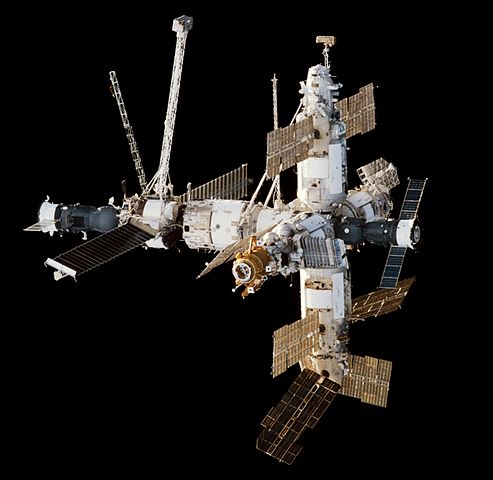The Russian Space Station Mir orbited the Earth from 1986 until 2001. Over that time, it served as ever-expanding space laboratory where research on a wide variety of subjects was conducted. The legacy of the Salyut space station series before it, Mir was designed with multiple berthing ports for expansion modules, allowing for more specialized research and an increase in the stations capabilities.
Mir was in orbit through my childhood and early teen years. As a kid who absolutely loved (and still loves) space travel, the idea of a massive, clustered Space Station like Mir was something of science fiction become reality. Sure, while the United States had Skylab in the early 70’s, and the Soviet Union, and by extent Russia, had the Salyut stations, I wouldn’t know much about them as a kid, what with the internet barely being a thing, thus limiting my research capabilities, Mir was something real, and current. I remember taping dockings of Mir and the Space Shuttle (and indeed, I actually have that tape in my room right now) as well as catching the occasional CNN or CSPAN news piece about what was going on with the American astronauts on Mir.

The Russian Space Station Mir
Indeed, I remember the 1997 Progress collision, which temporarily crippled the station and put the lives of the 3 crew members onboard at the time at risk. I remember the fire, and I remember that sad day in 2001 where a Space Station I love was commanded to re-enter the atmosphere and burn up over the pacific ocean.
By this time, in 2001, the International Space Station, which at it’s core uses backup components for Mir, was already well under construction and being inhabited by crews just as Mir was in its day.
Mir spent, at its core, 3 times it’s expected lifespan in orbit. While it was in the end a stepping stone for us to build the ISS and hopefully make our way to Mars and beyond, to me, it was the station of my childhood. It was something to dream about. I loved the way it looked, and I loved the idea of it, as being a one-of-a-kind machine orbiting the Earth while I was in grade school.
Interestingly, for as long as it was in orbit, there is very little footage of Mir to be found online. It’s mostly the same video clips, or very short “tours” from one module to the Shuttle, or back. Then, I found this video. An hour long documentary on the Space Station Mir, and what life was like on it.
While I disagree with some of the ways the station, and the Russian and American space programs are portrayed here, overall I would think this is a nice enough documentary, especially when given the lack of similar content out there.
Also, I do apologize for the advertisement in the middle of the video. It’s not my upload, and I guess the original uploader wanted to squeeze that in there. It is what it is.
Enjoy!
https://en.wikipedia.org/wiki/Mir
https://en.wikipedia.org/wiki/Shuttle%E2%80%93Mir_Program
